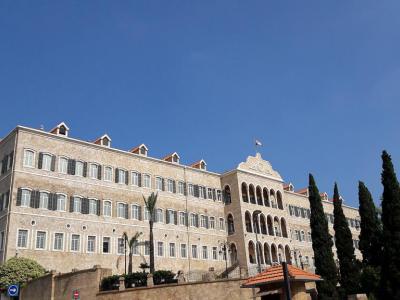Grand Serail (Government Palace), Beirut
Ibrahim Pasha of the Egyptian military discovered the hill in 1831 when he had briefly expelled the Ottoman occupiers from Beirut. Ibrahim Pasha liked the hill. It was ideally situated away from the crowded city and it overlooked the sea. The Ottomans returned in 1840. They also liked the hill. It was a great spot for a military base.
Today the Serail Hill is the site of the old Ottoman barracks, the Serail. It sits in downtown Beirut, a few blocks away from the Lebanese Parliament building. The Grand Serail is the most important of the three Ottoman monuments on the hill. The other two are the Council for Development and Reconstruction (CDR) and the Hamidiyyeh clock tower.
In 1853 the Ottoman government began fortifications. Final modifications of the Serail were made by 1894. Sultan Abdulaziz had added a hospital in 1865. The hospital had two wings for an infirmary and an apothecary. In 1918 The French turned the hospital into a courthouse. The site is now the Institute of Fine Art of the Lebanese University.
The architecture of the Serail is akin to the austere facade of the Selimiye Barracks of Istanbul. There are two high-ceiling levels with a facade more than 260 feet long. The east side has a portico arcade with two wings. Each wing has three rows of 16 windows. The four wings of the Serail enclose a courtyard with a limestone fountain.
The facades, inside and out, have 588 arches and arcades. The style of arches include lobed, pointed, rounded and mandolin. There are 92 pointed arcades. The Serail is currently the Office of the President of the Council of Ministers of Beirut.
Former Primte Minister Rafic Hariri installed a plaque over the entrance arch reading: "If political rule lasts perpetually for anyone, it would not have reached you."
Today the Serail Hill is the site of the old Ottoman barracks, the Serail. It sits in downtown Beirut, a few blocks away from the Lebanese Parliament building. The Grand Serail is the most important of the three Ottoman monuments on the hill. The other two are the Council for Development and Reconstruction (CDR) and the Hamidiyyeh clock tower.
In 1853 the Ottoman government began fortifications. Final modifications of the Serail were made by 1894. Sultan Abdulaziz had added a hospital in 1865. The hospital had two wings for an infirmary and an apothecary. In 1918 The French turned the hospital into a courthouse. The site is now the Institute of Fine Art of the Lebanese University.
The architecture of the Serail is akin to the austere facade of the Selimiye Barracks of Istanbul. There are two high-ceiling levels with a facade more than 260 feet long. The east side has a portico arcade with two wings. Each wing has three rows of 16 windows. The four wings of the Serail enclose a courtyard with a limestone fountain.
The facades, inside and out, have 588 arches and arcades. The style of arches include lobed, pointed, rounded and mandolin. There are 92 pointed arcades. The Serail is currently the Office of the President of the Council of Ministers of Beirut.
Former Primte Minister Rafic Hariri installed a plaque over the entrance arch reading: "If political rule lasts perpetually for anyone, it would not have reached you."
Want to visit this sight? Check out these Self-Guided Walking Tours in Beirut. Alternatively, you can download the mobile app "GPSmyCity: Walks in 1K+ Cities" from Apple App Store or Google Play Store. The app turns your mobile device to a personal tour guide and it works offline, so no data plan is needed when traveling abroad.
Grand Serail (Government Palace) on Map
Sight Name: Grand Serail (Government Palace)
Sight Location: Beirut, Lebanon (See walking tours in Beirut)
Sight Type: Attraction/Landmark
Guide(s) Containing This Sight:
Sight Location: Beirut, Lebanon (See walking tours in Beirut)
Sight Type: Attraction/Landmark
Guide(s) Containing This Sight:
Walking Tours in Beirut, Lebanon
Create Your Own Walk in Beirut
Creating your own self-guided walk in Beirut is easy and fun. Choose the city attractions that you want to see and a walk route map will be created just for you. You can even set your hotel as the start point of the walk.
Beirut Introduction Walking Tour
How many times can a city die? Beirut, in 5,000 years, has died and come back many times. Archeological digs downtown have revealed Phoenician, Greek, Roman, Byzantine, Arab, Crusader and Ottoman remains and signs of influence.
In 140 BC the city was destroyed by Diodotus Tryphon, a king of the Seleucid Empire. His Hellenistic city lies over the Phoenician one. Pompey the Great arrived in 64 BC... view more
Tour Duration: 2 Hour(s)
Travel Distance: 3.3 Km or 2.1 Miles
In 140 BC the city was destroyed by Diodotus Tryphon, a king of the Seleucid Empire. His Hellenistic city lies over the Phoenician one. Pompey the Great arrived in 64 BC... view more
Tour Duration: 2 Hour(s)
Travel Distance: 3.3 Km or 2.1 Miles
Seaside Walking Tour
If you wish to unwind or, perhaps, seek some quality time with your family and friends in a completely safe environment, while in Beirut, the local seaside area offers ample opportunities for both. Lined with palm trees, the city's waterfront guarantees a truly joyful experience and is as much fun for watching the Mediterranean, beautiful people and breathing the air as it is for exploring... view more
Tour Duration: 2 Hour(s)
Travel Distance: 3.2 Km or 2 Miles
Tour Duration: 2 Hour(s)
Travel Distance: 3.2 Km or 2 Miles





